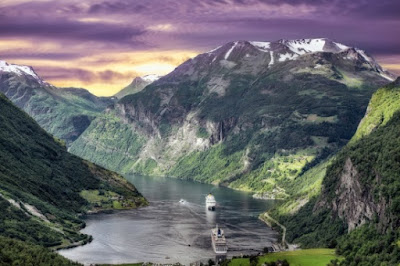Landforms Indicate Thin Ice Sheets
Secular geologists not only believe that the earth is billions of
years old, but that it had dozens of ice ages. Those are easy to invoke
since a later ice age effectively obliterates whatever happened
previously. Biblical creationists postulate only one Ice Age which was
caused by the global Genesis Flood. Landforms in Scandinavia and Britain
indicate thin ice sheets, contrary to secular views.
I wanted to check out the landforms in Norway but needed to rent a car. My preference was a Fjord Mustang —
"That's dreadful, Cowboy Bob!"
Oh, I thought you'd take a viking to that one. Moving on...
Geologists have ideas about ice sheets in Scandinavia and Britain, but their views and numerous assumptions are not supported by observed evidence. In addition, they rely on the Milankovitch (or astronomical) theory of ice ages and for scare tactics of climate change proponents. They still saddle up those faulty ideas because their impetus is the narrative, not the facts; the Milankovitch idea has been fundamentally flawed for decades, and its supporting Pacemaker idea has been refuted. Creation science views potentially explain much of what has been found, including why fjords are deeper closer to the mountains than they are toward the sea.
 |
| Credit: Pixabay / Enrique Lopez |
"That's dreadful, Cowboy Bob!"
Oh, I thought you'd take a viking to that one. Moving on...
Geologists have ideas about ice sheets in Scandinavia and Britain, but their views and numerous assumptions are not supported by observed evidence. In addition, they rely on the Milankovitch (or astronomical) theory of ice ages and for scare tactics of climate change proponents. They still saddle up those faulty ideas because their impetus is the narrative, not the facts; the Milankovitch idea has been fundamentally flawed for decades, and its supporting Pacemaker idea has been refuted. Creation science views potentially explain much of what has been found, including why fjords are deeper closer to the mountains than they are toward the sea.
Just like the Laurentide Ice Sheet, the Scandinavian and British-Irish Ice Sheets were much thinner than the Antarctic Ice Sheet, which is used as an analogue for ice sheet thickness by uniformitarian scientists. This supports a higher sea level minimum in the creation science Ice Age model. The evidence for much thinner ice sheets in Europe includes tors, relatively thick soils, saprolite, blockfields, and slightly modified drainage features within the area covered by the ice sheets. These non-glacial landforms are even found at the proposed centre of the Scandinavian Ice Sheet over north-east Sweden that extends into northern Finland. To preserve such landforms, the ice sheet in these areas must have eroded the substrate very little over a few million years. Secular scientists are convinced the Scandinavian Ice Sheet was up to 3–4 km thick, and are forced to conclude these areas had been covered by cold-based ice, which causes little erosion. Nunataks are supposed to have protruded above the ice sheets, but uniformitarian scientists are forced to claim that the trimlines on nunataks are the boundary between warm ice below and cold ice above, instead of the boundary between ice below and no ice above. Some of the delicate pre-glacial features can potentially be explained by late Flood events and the unique post-Flood Ice Age.To read the rest, click on "Non-glacial landforms indicate thin Scandinavian and British-Irish Ice Sheets".